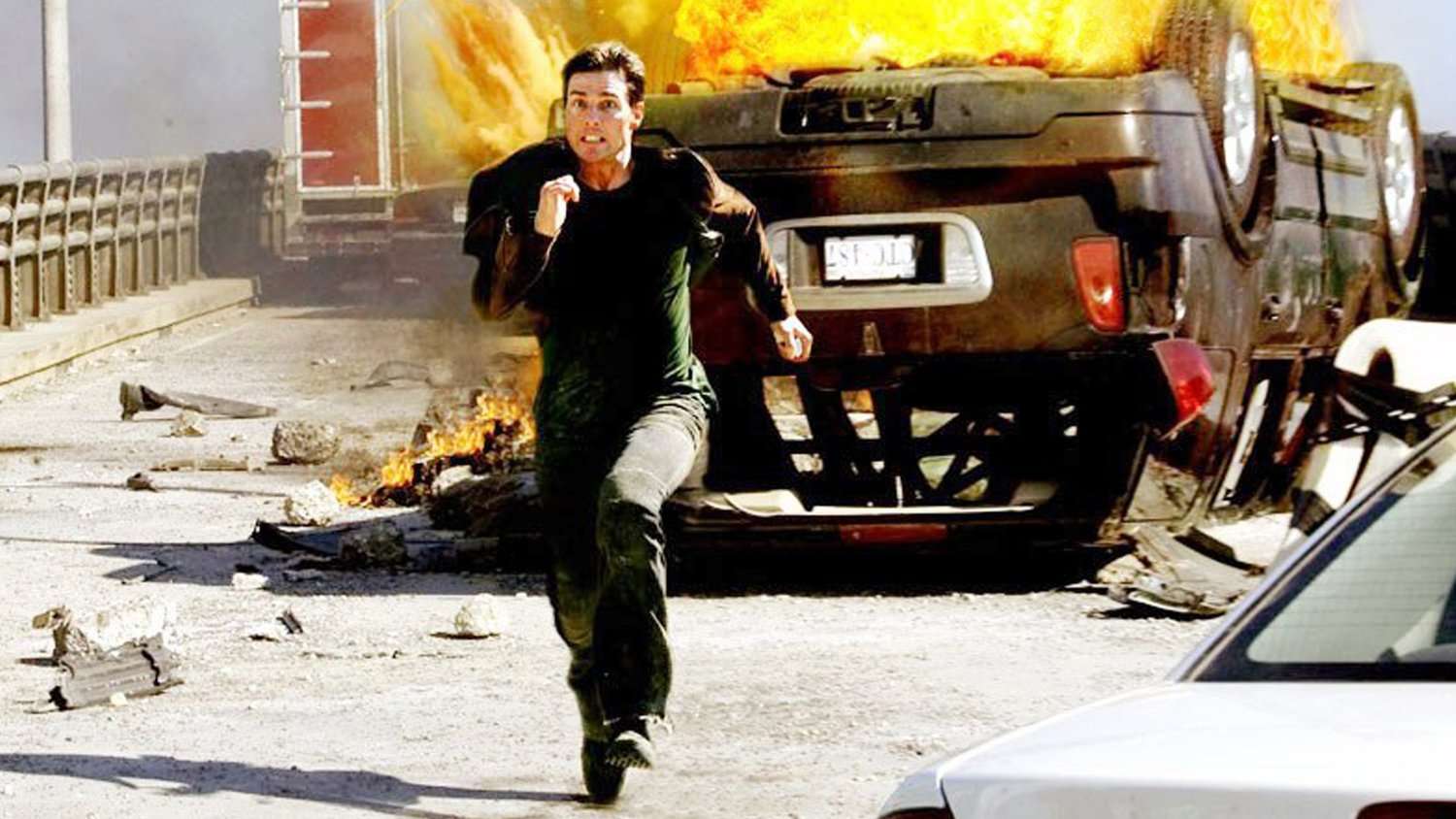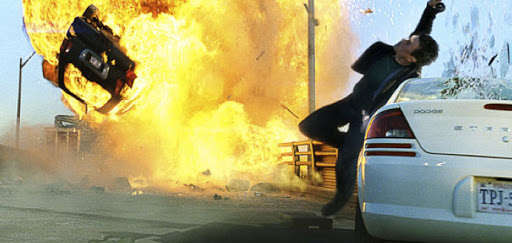Create a free profile to get unlimited access to exclusive videos, sweepstakes, and more!
Why you should give J.J. Abrams' feature debut, Mission: Impossible III, a second chance

“We’ve put an explosive charge in your head.”
That’s villain Owen Davian (Phillip Seymour Hoffman) in Mission: Impossible III’s intense opening scene, which sets the stage for one of the many great moments in this underrated sequel. The feature film debut of director J.J. Abrams is seemingly fueled by the mandate to subvert both the genre and fans’ expectations in a way that virtually resets the M:I franchise to become what it is today. Without this third entry, there would be no Ghost Protocol, Rogue Nation, or (*perish the thought*) Fallout.
Given how important this movie is to the evolution of Tom Cruise’s venerable series, it’s surprising to see how indifferent fans are to it. The 15th anniversary of M:i:III's release this week is a perfect time to change all that.
Mission: Impossible III is the action movie equivalent of an “intimate epic.” Like Abrams did before with his ABC spy drama Alias, the filmmaker grounds the extraordinary exploits of his spy — this time, it’s IMF’s all-star operative Ethan Hunt (Cruise) — firmly in a character-driven, relatable world. When we find Ethan after the slow-mo, flying dove exploits of John Woo’s Mission: Impossible 2, he is engaged to Julia (the insanely likable Michelle Monaghan) and no longer in the field. At Ethan and Julia’s festive engagement party at their cozy, suburban Virginia home, the spy is keenly aware (and somewhat amazed) that he’s spent 10 years with his agency at this point (which, per his cover story, he refers to as the Department of Transportation).
Soon, Ethan is forced back into spy mode when he learns that his former protegee, Agent Farris (Keri Russell), has been captured by Davian. The world’s going to lose a hero unless Ethan comes to her rescue, so he scrambles a team — which includes Maggie Q, Jonathan Rhys Meyers, and Mission staple Ving Rhames — to retrieve Farris and stop Davian before he can unleash a mysterious doomsday MacGuffin called the Rabbit’s Foot. Along the way, Ethan infiltrates the Vatican, gets married, dangles a man out of a plane, watches what he thinks is his wife get shot, endures the aforementioned time bomb in his brain, and — most memorably — gets detonated sideways into a Dodge Stratus.
Mission III is full of the type of puzzle-plotting and white-kunckle set pieces audiences love in movies like this, so why wasn’t it a bigger hit?
Well, from the (pun intended) jump, Mission: Impossible III got a bad rap.
Paramount Pictures’ marketing campaign for the would-be blockbuster, which was scheduled to kick off the 2006 summer movie season, took a significant hit when its star jumped on Oprah’s couch to profess his love for then-wife Katie Holmes. The viral backlash that stemmed from Cruise’s appearance, coupled with the headlines surrounding the in-fighting between the late Viacom head Sumner Redstone and Cruise, gave the much-hyped sequel an air of box office radioactivity. To drown out the bad buzz and change the newscycle, Paramount re-doubled their efforts by engaging in a marketing blitzkrieg that included an elaborate premiere stunt in NYC that would have Cruise arrive in the city via land, sea, and air. (I actually worked for Paramount’s Marketing group at the time, and the original plan was to have Cruise parachute out of a helicopter and land at the premiere site. That was nixed due to obvious safety reasons.)
Despite a full-court press, M:i:III’s opening weekend of $47.7 million was below expectations — and $10 million less than what the previous installments earned during their debuts. M:i:III’s underperformance at the box office led to Cruise’s stardom losing its luster for the first time in his career, leaving the future of the franchise — one of the few cash cows Paramount could rely on — in jeopardy. It’s ironic then that the movie that “tarnished the brand” is what ultimately helped give it a second wind.
Credit Mission’s resurgence to the character-first script written by Abrams, Alex Kurtzman, and Roberto Orci. Sure, Abrams' visual style — fresh off TV shows Alias and Lost — struggles at times to fully embrace the brand-new anamorphic landscape his blockbuster debut afforded him, but what this sequel sometimes lacks in visual spectacle, it makes up for with some of the series’ best emotional beats.
Abrams nails all of the quieter scenes between newlyweds Ethan and Julia. Especially the moments where Ethan struggles not to lie to the love of his life when what he does for work threatens to literally blow them up. The cost of living a public life in service of secretly saving lives is a theme Abrams dined out on during his Alias days, and it more than serves him and his star here on the big screen. For Mission III is the first film in the series to peel back the curtain on who Ethan is as a person, in-between all the kick-punching. In doing so, the stakes couldn’t be more personal for Hunt, as he races against time (and across China) to stop Davian, who effortlessly wins the award for the franchise’s best (and most punchable) baddie.
The constant pull between Ethan’s personal life and his professional one allows for some truly inventive, edge-of-your-seat fun at the movies. The opening scene reflects that perfectly, as it throws us into the middle of a bad situation that only gets worse for Ethan. The questions of where are we, and why is this guy yelling at our hero — those are intentional. The movie is designed to throw us off-center with an opening scene that invests us firmly in Ethan’s plight, and Cruise’s charisma makes it impossible not to immediately root for the character. So when the bigger and more explosion-y stuff happens, its impact is that much greater because of the care space established between us and the guy in the middle of all those fireballs.
The franchise's most underrated sequence, breaking into the Vatican, is a Swiss watch — a perfectly structured mix of thrills and tension that will make you fist-pump when Hunt and his IMF team finally pull it all off. Also cool? That iconic battle on the bridge that pits Ethan against a missile-firing drone, along with a very contained fight scene in an elevator that culminates in a face-masked Ethan incapacitating a few guards with a telephone. While not as “big” as subsequent Mission installments, Abrams' feature-film debut helped set the tone that those future films would follow.
It also set a narrative template that future sequels would (consciously or unconsciously) use. That structure involves a mid-point action sequence that upends Ethan’s world and changes the stakes of his mission (usually in a very personal way), followed by 10 to 15 minutes of more action — often in the form of a chase either on foot or, in the case of Rogue Nation, via motorbike. This gauntlet of action stretches from the middle of the movies to the two-thirds mark, or the end of the second act, which traditionally finds a hero at their lowest point. For Ethan in the Mission movies, that’s especially true. He often finds himself forced to go on the run (either from the bad guys, or his own agency, or, in the case of M:i:III, both). When he’s done playing fugitive, he then regroups with his team before eliminating or capturing the Big Bad and saving the world. (Before Fallout, the third acts of Mission movies applied action-y solves to their villain problem at a scale much smaller than the action that preceded them.)
The smaller and more intimate approach Mission: Impossible III took to the series and to Ethan as a character is a choice that continues to pay off to this day. Having shown its top in Woo’s Mission: Impossible II, the series had to reground itself. Mission used its third chapter as a foundation, a launch pad to realign the character and bring him back to a more “everyday hero” place that helped make Brian De Palma’s first Mission: Impossible movie so successful. Abrams found a very human, very personal way into the character of Ethan Hunt, and through that, the franchise found a way to boost its longevity and the character’s likability through each subsequent installment.
And it all started with an explosive charge inside Tom Cruise’s head.
The views and opinions expressed in this article are the author's, and do not necessarily reflect those of SYFY WIRE, SYFY, or NBCUniversal.



























